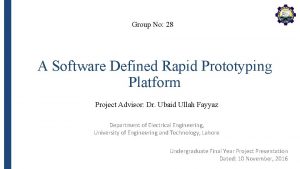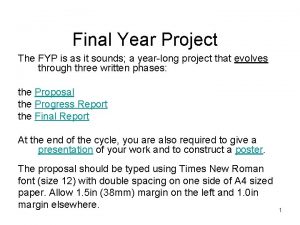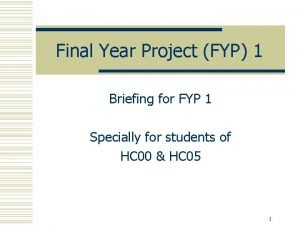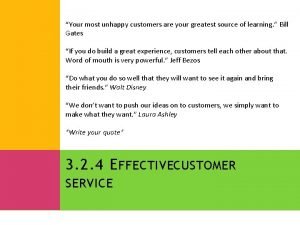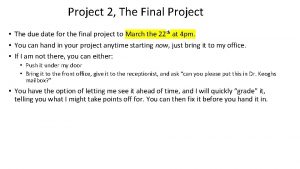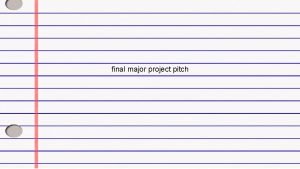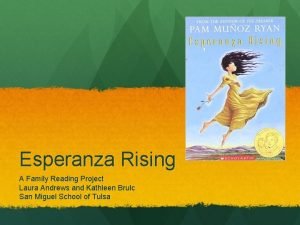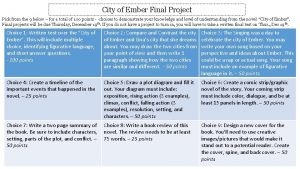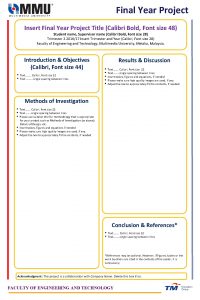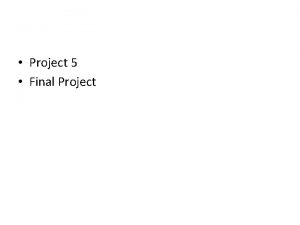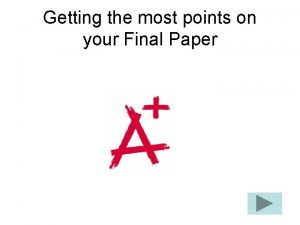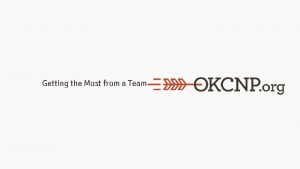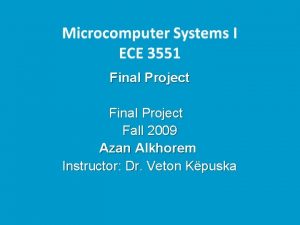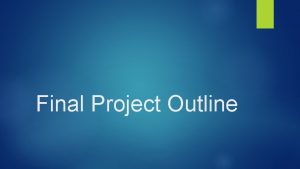Getting the most from your final year project






















- Slides: 22

Getting the most from your final year project. Martin Greenhow Project coordinator Health Warning: Your project is a degree requirement and is worth 2/9 ths of your degree = 1 day per week STARTING NOW!

Requirements § See the REQUIREMENTS GUIDE 70 pages - MAXIMUM No padding - you’ll loose marks for this! § Your project report should be a “narrative text” with a coherent story line which flows logically from one section to the next in a coherent manner. You can include documentation/program listing in appendices and/or disc.

You should by week 5: § have a good idea about what your project will involve. § have read some previous projects in the same area and started on related textbooks. § have searched the WWW (8 am start for US sites!) & other material in the Library. § have started to make notes from these sources; keep this focussed and don’t copy out sections from books, download chunks from the Web or CDs - this is plagiarism! You will synthesise these notes into a narrative later- see the Study Skills Guide. § have written down exact references as you find them - see the Study Skills Guide. § have started a week-by-week log book. § have seen your supervisor at least 3 times.

You should by Xmas: § have a good understanding of theory and methods to be used. § have read most of the background material and made notes/references. § have made a start on any programming involved. It is not possible to write a decent program without completely understanding what you want/need to do, so ask your supervisor if anything is not clear. Then draw a flow chart or write “pseudo code” to specify how the program will work before getting bogged down in language syntax. Back-up all programs. § have considered writing drafts as you go along to aid your thinking; in mathematics this technique is perhaps less useful, but you must keep very detailed notes and back them up with photocopies or notes on your PC (AND Brunel network). § have seen your supervisor at least 8 times.

Before the Xmas break § Make sure your log book is up to date l l l include failures as well as successes include how long it took you to do each item write down ALL ideas you have as you work (they will be useful for your Recommendations). § Discuss your project plan with your supervisor. § Prepare/document/back-up everything so you can start again after the break.

Inter-Semester weeks. § Blitz your project! § Generate and organise your results

Talk and Draft Plan (=10 credits) § Prepare your project plan and ask your supervisor for comments, especially on your plans & REALISTIC timings for further work § Think about interim conclusions and how you will communicate your results in graphs, charts, flow charts, spray diagrams, trees etc. § Prepare and practice your presentation, asking friends to time each OHP slide. § Read the advice in the Study Skills Guide – yes really do this!

Sample Gantt chart Tasks Week 1 Week 2 Week 3 Week 4 Week 5 Week 6 Week 7 Week 8 Complete Product rule lib. Evaluation Analysis Complete quotient rule lib. Evaluation Analysis Complete Chain rule lib. Evaluation

By the start of Easter you should: § have finished all the actual project content. § have written the main sections and typed them up. § have acted on your supervisor’s comments on your draft chapters. § have produced all the graphs and diagrams. § have checked your supervisor’s availability over Easter.

Over Easter you should: § swap drafts with friends for comment. If your friends can’t understand what you have done in broad terms, it’s YOUR fault. § write the abstract, introduction, conclusions and recommendations sections. Give these to your supervisor for comment in good time. § finalise any appendices, references and program discs. § act on your supervisor’s comments. § put all sections together, check spelling and grammar, include headers, footers and page numbers. § print it all out - beware print queues at this time of year!

The report itself - general points. § The object of your report is to communicate, not impress or blind with science! § Help your reader as much as possible. § Use ordinary plain English, free of jargon and slang. § Use diagrams, charts etc as much as possible. § Stick to conventional and consistent nomenclature.

The report itself - the start. § § § Title page - see the Requirements Guide. Acknowledgements - keep it formal! Table of contents. List of figures. Nomenclature, Definitions and Non-dimensionalisation. Abstract of about 1 -2 sides. The abstract is an important guide to the reader and must describe the main area of the work and your main results. Usually written last.

The report itself - the Introduction. § § § What the project is about. A “map” of the work undertaken. Why your work is interesting/important. Possible applications. A review of previous work. A clear statement of how you have extended the previous work. § The introduction is usually written at the end of the project.

The report itself - the Method. § This can be very technical, so help your reader “navigate” through the work by: l clearly stating your assumptions. l stressing what is most important. Move some material to appendices. l using logical paragraph, section & chapter breaks. l using diagrams, charts, flow charts. l using equations with all terms defined; consider reminding the reader of earlier definitions. § Think strategy, not detail. § The method section is often written early and goes through a few drafts as the work progresses and the supervisor comments on it.

The report itself - the Results. § This can be very technical, so help your reader as before. § When presenting results you should: l state any limitations on the generality of your results. l state the accuracy of your results. l describe the sensitivity of your results to changes in assumptions and parameter values. l Reconsider the model assumptions and refine them if possible (a modeling cycle). § Explain your results; if you can’t/won’t do this, how do you expect the reader to be able to? § The results section is often written early and goes through a few drafts as the work progresses and the supervisor comments on it.

The report itself - the Conclusion. § This must not contain new ideas. § This must contain only statements which are supported by your work and follow naturally and logically from it. § Draw some conclusions, probably taking several pages of text; if you can’t/won’t do this, why do you expect the reader to do it for you? § NB The conclusion is worth a lot of attention - and marks!

The report itself - the Recommendations. § This should contain many of the ideas which will have occurred to you as you worked, and which were written down in your log book … weren’t they? § This must contain ideas for future work. Imagine yourself starting a similar project … what would you want to read? Be as specific as possible about: l new applications of the present theories/techniques. l application in areas with similar mathematical structures. l Extensions which avoid the limitations/weaknesses of your work. Be honest - this is a sign that you know what you are doing and will be rewarded rather that penalised! § NB The Recommendations are worth a lot of attention - and marks!

The report itself - the Appendices. § § § Program listings - on a disc to help future students. Data printouts - again on disc. List of software used. Logbook. Instructions for reading data and/or running any programs on the disc. Remember that the External Examiner may well want to do this, so be specific and include everything that is needed unless this infringes copyright laws. § Proofs and material which underpins, but is not part of, the main narrative. § Include material here which will help future students.

The report itself - the References. § Books. l Greenhow M. (1982)“My life as a dog” Oxford Univ. Press 4 th ed. § Journals. l Greenhow M. (1937) “The mathematics of guinea pig sexing” J. Math. Biol. , 8, part 4, pp 1 -59. § Electronic sources: WWW - state exact URLs and date when accessed. l Graphics from Encarta (or similar) needs to be referenced. l Remember: NO DOWNLOADING! § NB Read the Study Skills Guide – see the examples on plagarism. l

When you get stuck. § § § Can you define all your terms? What are the dimensions of terms in your equations? Can you non-dimensionalise your equations? What are the important parameters? Can you draw a flow chart for your program and check each part separately? § Can you run simple test cases to compare your program results against analytical results? § Write all variables to a file if your program gives unexpected results, and check them carefully.

When you get stuck again! § Can you simplify your problem? § Can you exploit any symmetry in your problem? § Can you do sample calculations at e. g. x = 0, 1 etc? § Can you do any sort of asymptotic analysis as x becomes small or big? § Can you plot your results in a different way? § Can you explain your problem to your supervisor or another student? If you can, you are half way to solving it!

Submission. § Usually at the end of Easter; date for 2003/2004 is: *tba* 2004. § Penalties for late submission: l l l § 1 day = 4% subtracted. Subsequent days = 2% subtracted. This includes weekends and holidays! Plagiarism = No degree ! § NB See the marks allocation on the project syllabus and allocate your time accordingly. Note that students often throw marks away by poor presentation and/or inadequate abstracts, introductions, conclusions and, especially, recommendations.
 The secret of getting ahead is getting started
The secret of getting ahead is getting started 3.05 getting the most for your money
3.05 getting the most for your money Methodology fyp
Methodology fyp Gantt chart for final year project
Gantt chart for final year project Final year project methodology example
Final year project methodology example Final year project presentation
Final year project presentation How to make final year project presentation
How to make final year project presentation Utar turnitin
Utar turnitin B.tech final year project report sample
B.tech final year project report sample Fyp introduction
Fyp introduction Fyp presentation slides templates
Fyp presentation slides templates Final year project presentation
Final year project presentation Augmented reality final year projects
Augmented reality final year projects Your most unhappy customers are your greatest
Your most unhappy customers are your greatest Poem for primary school leavers
Poem for primary school leavers Give us your hungry your tired your poor
Give us your hungry your tired your poor Freak the mighty final project
Freak the mighty final project Final project due
Final project due Marine biology experiment ideas
Marine biology experiment ideas Major project proposal
Major project proposal Esperanza rising final project
Esperanza rising final project City of ember project
City of ember project World history final project ideas
World history final project ideas



